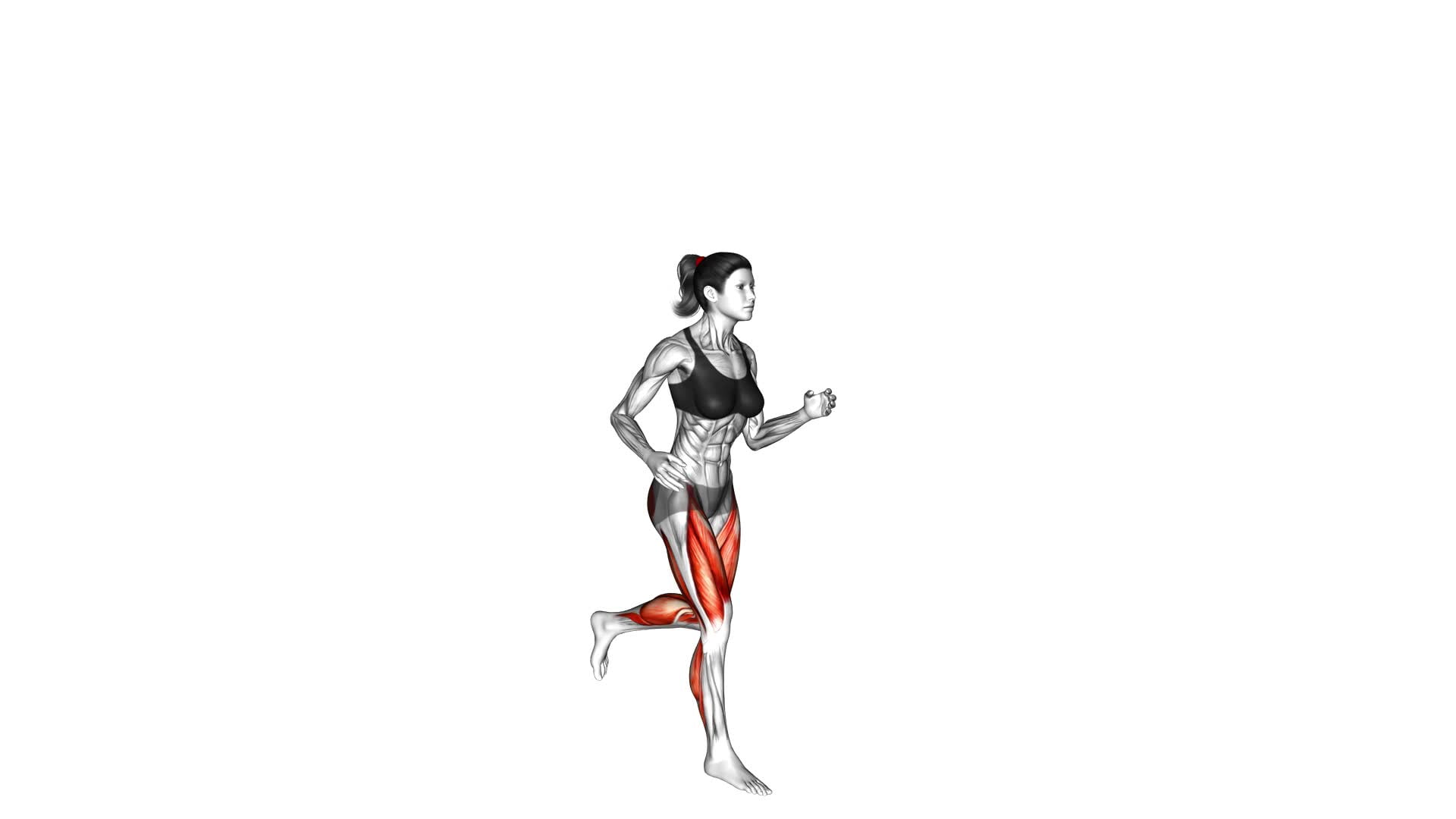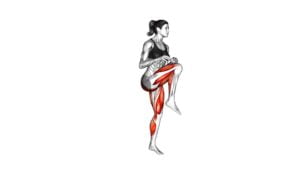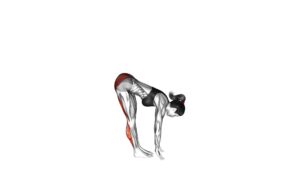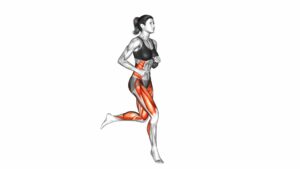Run and Half Knee Bend (female) – Video Exercise Guide & Tips

Are you looking for a new exercise to incorporate into your routine?
Watch This Exercise Video
Try the Run and Half Knee Bend!
This video exercise guide and tips will show you the proper form and technique for this dynamic movement.
You'll discover the benefits of this exercise, as well as modifications and progressions to challenge yourself.
Don't miss out on this opportunity to improve your fitness level.
Get ready to break a sweat and achieve your goals!
Key Takeaways
- Targets multiple muscle groups
- Improves cardiovascular endurance
- Strengthens core muscles
- Maintains balance and stability
Benefits of the Run and Half Knee Bend
You should regularly incorporate the run and half knee bend into your exercise routine to reap its numerous benefits. The run and half knee bend is a dynamic exercise that targets multiple muscle groups and improves cardiovascular endurance. By combining running with a half knee bend, you engage your lower body muscles, including the quadriceps, hamstrings, calves, and glutes. This exercise also strengthens your core muscles and improves your balance and coordination.
One of the key benefits of the run and half knee bend is that it helps to burn calories and promote weight loss. It's a high-intensity exercise that increases your heart rate and boosts your metabolism, resulting in increased calorie expenditure. Additionally, this exercise improves your cardiovascular fitness, as it challenges your heart and lungs to work harder.
To perform the run and half knee bend with proper form, start by standing tall with your feet hip-width apart. Begin running in place, lifting your knees as high as possible while maintaining a fast pace. As you continue running, bend your knees halfway as if you were performing a squat. Make sure to keep your back straight and your core engaged throughout the exercise. By maintaining proper form, you can maximize the effectiveness of this exercise and prevent injuries.
Incorporating the run and half knee bend into your exercise routine won't only help you achieve your fitness goals but also improve your overall health and well-being. So lace up your sneakers, give it a try, and experience the amazing benefits of this dynamic exercise.
Proper Form and Technique
To perform the Run and Half Knee Bend exercise with proper form and technique, it's crucial to focus on correct body alignment. Keep your head up, shoulders back, and maintain a straight line from your head to your heels.
Avoid common mistakes such as rounding your back or hunching your shoulders, as this can lead to injury and reduce the effectiveness of the exercise.
Correct Body Alignment
Achieving proper body alignment is crucial for maximizing the effectiveness of the run and half knee bend exercise. Proper body alignment refers to maintaining a straight and balanced posture throughout the movement. This alignment is essential for several reasons.
Firstly, it helps to distribute the workload evenly across your muscles, preventing imbalances and reducing the risk of injury.
Secondly, it allows you to engage the correct muscles and target the intended areas effectively.
Lastly, proper body alignment ensures that you're getting the most out of each repetition, maximizing the benefits of the exercise.
To achieve correct body alignment, focus on maintaining a straight spine, engaging your core muscles, and keeping your shoulders back and down.
Avoiding Common Mistakes
Maintaining proper form and technique is essential for avoiding common mistakes while performing the run and half knee bend exercise. To ensure you get the most out of this exercise, here are some tips for improvement:
- Avoid rounding your shoulders: Keep your chest lifted and your shoulder blades pulled back and down. This will help maintain good posture throughout the exercise.
- Don't forget to engage your core: Activate your abdominal muscles by pulling your belly button in towards your spine. This will help stabilize your body and prevent any unnecessary strain on your lower back.
- Keep your knees aligned: Make sure your knees are tracking over your toes and not collapsing inward. This will help protect your knees and ensure proper alignment of your lower body.
By following these tips, you can avoid common mistakes and perform the run and half knee bend exercise with proper form and technique, maximizing its benefits for your body.
Keep pushing yourself and enjoy the results!
Importance of Proper Technique
To ensure you get the most out of the run and half knee bend exercise, it's important to focus on proper technique and form. The importance of correct technique can't be overstated.
By performing the exercise with proper form, you can maximize the benefits and avoid potential injuries. Proper technique ensures that you engage the correct muscles and target the intended areas of your body. It also helps you maintain balance and stability throughout the exercise, reducing the risk of falls or strains.
Additionally, proper form allows for efficient movement and optimal muscle activation, leading to improved strength and endurance. So, remember to pay attention to your technique and form during the run and half knee bend exercise to reap the full benefits.
Equipment Needed for the Exercise
You will need equipment for this exercise. Here are the essential items you'll need to perform the run and half knee bend exercise:
- Running Shoes: Make sure you have a good pair of running shoes that provide proper support and cushioning. This will help reduce the risk of injury and provide comfort during the exercise.
- Comfortable Workout Clothes: Wear breathable and comfortable workout clothes that allow for easy movement. This will help you focus on the exercise without any distractions.
- Exercise Mat: Having a soft exercise mat can provide additional cushioning and support when performing the half knee bend. It will also protect your knees from the hard floor.
Remember, variations and modifications can be made to suit your fitness level and goals. If you find the exercise challenging, you can start by performing the run and half knee bend at a slower pace or with a smaller range of motion. As you become more comfortable, you can increase the intensity by adding weights or performing the exercise on an inclined surface.
Having the right equipment will ensure that you can perform the run and half knee bend exercise safely and effectively. So, gather your gear, put on your running shoes, and get ready to take your workout to the next level!
Modifications and Progressions
Now that you've learned the basic run and half knee bend exercise, it's time to explore modifications and progressions to challenge yourself even further.
One modification you can try is the modified knee bend, where you reduce the depth of the knee bend to make it easier on your joints.
For those looking for a greater challenge, advanced progressions like adding weights or increasing the speed can help take your workout to the next level.
However, it's important to remember to prioritize safety and listen to your body when making modifications.
Modified Knee Bend
Start with a modified knee bend, making adjustments and advancing your technique. Here are some variations of knee bend techniques that you can try:
- Begin with a shallow knee bend, gradually increasing the depth as you build strength and flexibility.
- Experiment with different foot placements, such as wider or narrower stances, to target different muscle groups.
- Incorporate balance challenges by performing the knee bend on an unstable surface, like a foam mat or Bosu ball.
By modifying your knee bend, you can tailor the exercise to your specific needs and goals. As you become more comfortable with the modified knee bend, you can progress to more advanced variations. These advanced progressions will help you further challenge your muscles and continue to improve your strength and stability.
Advanced Progressions for Modification
To advance your knee bend technique, try incorporating these advanced modifications, variations, and progressions. These advanced techniques and modifications will challenge your muscles even more, helping you to build strength and improve your overall performance.
One advanced modification you can try is adding weight to your knee bend exercise. This can be done by holding dumbbells or using a weighted vest.
Another variation is to perform the knee bend on an unstable surface, such as a Bosu ball or a balance board. This will engage your core muscles and improve your balance and stability.
Additionally, you can progress to performing the knee bend on one leg, which will further increase the difficulty and work your muscles in a different way.
Remember to start with a weight and difficulty level that's appropriate for your fitness level and gradually increase as you become stronger and more comfortable.
Keep pushing yourself and enjoy the challenge of these advanced modifications and progressions!
Safety Considerations for Modifications
To ensure your safety while incorporating modifications and progressions, it's important to consider certain factors. Here are some safety precautions and injury prevention tips to keep in mind:
- Warm up properly before starting any exercise to prepare your muscles and joints for movement.
- Listen to your body and pay attention to any pain or discomfort. If something doesn't feel right, modify or stop the exercise.
- Use proper form and technique to avoid putting unnecessary stress on your joints and muscles.
- Start with modifications that are appropriate for your fitness level and gradually progress as you become stronger and more comfortable.
- Wear appropriate footwear and clothing to provide support and prevent injuries.
- Stay hydrated and take breaks when needed to prevent overexertion.
- Consult with a fitness professional or healthcare provider if you have any specific concerns or medical conditions.
Common Mistakes to Avoid
Avoid these common mistakes when performing the run and half knee bend exercise to ensure proper form and maximize results. By avoiding these mistakes, you can protect yourself from injury and make the most out of your workout.
One common mistake isn't maintaining proper posture while running. It's important to keep your back straight and your core engaged throughout the exercise. This will help you avoid putting unnecessary strain on your lower back and reduce the risk of injury.
Another mistake to avoid is rushing through the exercise. Take your time and focus on each movement. By performing the exercise with control and precision, you'll engage the correct muscles and maximize the benefits. This will also help prevent any jerky or unbalanced movements that can lead to injury.
Additionally, make sure to fully extend your legs when running and bending your knees. This will help you maximize the power and effectiveness of the exercise. It's also important to avoid locking your knees at any point during the movement, as this can strain your joints and increase the risk of injury.
Finally, don't forget to breathe properly throughout the exercise. Many people tend to hold their breath or take shallow breaths, which can limit oxygen flow and decrease performance. Take deep breaths in and out to supply your muscles with the oxygen they need and maintain a steady rhythm.
Tips for Incorporating the Exercise Into Your Routine
To effectively incorporate the run and half knee bend exercise into your routine, focus on maintaining proper form and gradually increasing intensity for optimal results. Here are some tips to help you incorporate this exercise into your workout routine:
- Start with a warm-up: Before performing the run and half knee bend exercise, make sure to warm up your body with some light cardio exercises such as jogging or jumping jacks. This will help prepare your muscles for the workout and reduce the risk of injury.
- Incorporate modifications: If you're new to this exercise or have any physical limitations, you can modify it to suit your needs. For example, you can decrease the range of motion for the knee bend or perform the exercise at a slower pace. Remember, it's important to listen to your body and only do what feels comfortable for you.
- Safety considerations: As with any exercise, safety should be a top priority. Make sure you have enough space to perform the exercise without any obstacles. Also, pay attention to your form throughout the exercise to avoid any strain or injury. If you experience any pain or discomfort, stop immediately and consult a healthcare professional.
By incorporating modifications and considering safety precautions, you can effectively add the run and half knee bend exercise to your routine and achieve your fitness goals. Remember to always listen to your body and gradually increase the intensity as you become more comfortable and stronger.
Keep pushing yourself, and you'll see progress in no time!
Frequently Asked Questions
How Many Calories Does the Run and Half Knee Bend Exercise Burn?
If you're wondering how many calories you can burn with the run and half knee bend exercise, you're on the right track for weight loss.
This exercise is effective for burning calories and shedding those extra pounds. By incorporating running and knee bends, you engage multiple muscles and increase your heart rate, leading to a higher calorie burn.
Can Men Also Perform the Run and Half Knee Bend Exercise?
Yes, men can also perform the run and half knee bend exercise. It's a great exercise for men's fitness as it targets multiple muscle groups, including the legs, glutes, and core.
If you're looking for alternative exercises, you can try lunges, squats, or step-ups, which also provide similar benefits.
Remember to maintain proper form and gradually increase intensity to maximize results.
Stay committed and you'll see progress in no time!
Is It Necessary to Warm up Before Doing the Run and Half Knee Bend Exercise?
Before starting the run and half knee bend exercise, it's important for you to warm up. Warming up helps prepare your muscles for the workout, increasing blood flow and flexibility. It reduces the risk of injury and improves your overall performance.
If you're a beginner, there are alternative exercises you can do to build strength and gradually work your way up to the run and half knee bend.
Can the Run and Half Knee Bend Exercise Help Improve Running Speed?
To improve your running speed, the run and half knee bend exercise is a great choice. By incorporating plyometrics into your training routine, you can enhance your agility and power.
This exercise specifically targets your leg muscles, helping you to develop explosive strength and speed. By regularly practicing this exercise, you can see significant improvements in your running performance.
How Often Should the Run and Half Knee Bend Exercise Be Performed to See Results?
To see results from the run and half knee bend exercise, it's important to be consistent. Aim to perform this exercise at least three times a week. However, keep in mind that individual results may vary.
How long it takes to see results will depend on various factors such as your current fitness level, diet, and overall commitment to your workout routine. Additionally, while the run and half knee bend exercise can help tone your muscles, it's important to combine it with a balanced diet for weight loss.
Stay focused and motivated, and you'll start seeing improvements in no time.
Conclusion
Incorporating the run and half knee bend exercise into your routine can provide numerous benefits, including increased leg strength and improved cardiovascular endurance.
By maintaining proper form and technique, using the necessary equipment, and avoiding common mistakes, you can maximize the effectiveness of this exercise.
Remember to start with modifications if needed and gradually progress as you become more comfortable.
With dedication and consistency, this exercise can help you achieve your fitness goals.
Start today and feel the difference in your overall fitness level.

Author
Years ago, the spark of my life’s passion ignited in my mind the moment I stepped into the local gym for the first time. The inaugural bead of perspiration, the initial endeavor, the very first surge of endorphins, and a sense of pride that washed over me post-workout marked the beginning of my deep-seated interest in strength sports, fitness, and sports nutrition. This very curiosity blossomed rapidly into a profound fascination, propelling me to earn a Master’s degree in Physical Education from the Academy of Physical Education in Krakow, followed by a Sports Manager diploma from the Jagiellonian University. My journey of growth led me to gain more specialized qualifications, such as being a certified personal trainer with a focus on sports dietetics, a lifeguard, and an instructor for wellness and corrective gymnastics. Theoretical knowledge paired seamlessly with practical experience, reinforcing my belief that the transformation of individuals under my guidance was also a reflection of my personal growth. This belief holds true even today. Each day, I strive to push the boundaries and explore new realms. These realms gently elevate me to greater heights. The unique combination of passion for my field and the continuous quest for growth fuels my drive to break new ground.







